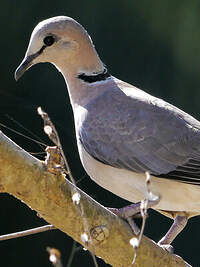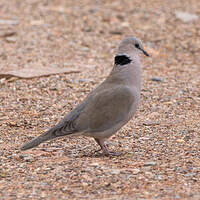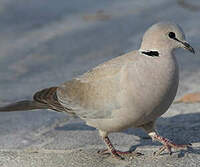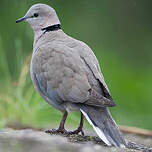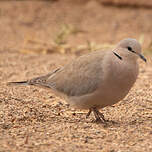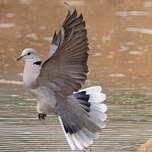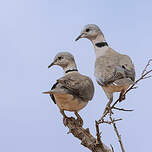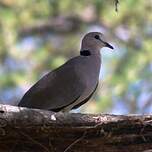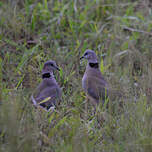Ring-necked Dove
Streptopelia capicola - Tourterelle du Cap
Identification
The Ring-necked Dove is very similar to our common Turtle Dove that we usually see in many countries. However, it is slightly smaller, almost 10 cm in length. Both genders look very similar but the male is slightly larger. The Ring-necked Dove is generally light grey-brown on the top and pale grey on the underside. Some parts are also paler, almost grey-pink. Its head is light grey with a hint of pale pink. Its nape is slightly darker than its forehead. The cheeks and throat are almost white. A black collar with a blue-white lining covers the back and sides of the neck, a characteristic visible in many species of the Streptopelia. A black line connects the lores with the eyes. The chest is pale grey-pink and this colour lightens as it goes down to the belly and flanks. The mantle, scapulars and tertials are brownish sand. The lesser, median and greater coverts are grey-blue. The primaries are brown with light beige edges. All of these three colours are easily seen when the bird is in flight. The back, rump and upper-tail coverts are grey-blue. The undertail coverts are white. The central rectrices are grey and contrast with two white outer feathers that can be seen at the take-off of the bird and are of great help to identify it when in groups of other species. Finally, the beak and cere are dark grey, the iris black and the legs red. Many colour variations exists depending on the lighting and distribution areas. The juvenile is more dull while the adult is rosy-violet and does not have a black collar.
Subspecific information 6 subspecies
- Streptopelia capicola capicola (w South Africa)
- Streptopelia capicola electa (w Ethiopia)
- Streptopelia capicola somalica (e Ethiopia, Somalia, n Kenya)
- Streptopelia capicola tropica (c Kenya to Angola and South Africa)
- Streptopelia capicola onguati (sw Angola, n Namibia)
- Streptopelia capicola damarensis (Namibia, Botswana, sw Zimbabwe)
Foreign names
- Tourterelle du Cap,
- Tórtola de El Cabo,
- rola-do-cabo,
- Gurrtaube,
- fokföldi gerle,
- Kaapse Tortel,
- Tortora dal collare del Capo,
- savannduva,
- Savannedue,
- hrdlička hrkútavá,
- hrdlička damarská,
- Savanneskoggerdue,
- aroturturikyyhky,
- Gewone Tortelduif,
- tórtora del Cap,
- synogarlica popielata,
- Южноафриканская горлица,
- アフリカジュズカケバト,
- 环颈斑鸠,
- savannduva,
- 環頸斑鳩,
Voice song and call
Habitat
The Ring-necked Dove prefers semi-desert areas, open areas, cultivated areas, and wooded gardens to deep forested areas.
Behaviour character trait
Even though the Ring-necked Dove can form large roosts and great morning gatherings at water sources, they live alone or in pairs and are monogamous.
These birds become very vulnerable in groups; being occupied while drinking, Ring-necked Doves become easy and many a prey for the Lanner Falcon and the Black Kite, but also Herons, Storks, Reptiles, Genets, Wild Cats and Jackals. These groups of hundred birds are also very loud due to their incessant calls throughout the day and often even on moonlit nights. During the breeding period, nests built close to one another within the same group cause rivalries and territorial disputes. The Ring-necked Dove is largely granivorous and forages on the ground. Therefore, it is often found in cereal crop areas where it takes advantage of and benefits greatly from, having irrigation water nearby.Flight
Dietfeeding habits
Reproduction nesting
The Ring-necked Dove breeds year-round. However, no cases of reproduction have been reported between October and January in Ethiopia.
To seduce the female, the male performs energetic wing-clapping in ascending flight, then approaches the female forming circles. On the ground, he parades with bowed head movements from bottom to top. After offering food, the couple can mate. The female builds the nest in 3 to 8 days, it's a simple platform of branches chosen beforehand by the male. The nest is placed on a low tree fork or a bush between 2 and 10 meters high but without any preference for the species of the tree. Old nests are often occupied by the couple. The female lays one or two cream-white eggs which will be incubated by both sexes for 13 to 15 days. As with all Columbiformes, the parents feed the young through regurgitation. The young leave the nest at 16 or 17 days and become independent after 12 to 18 days. One couple can raise 10 broods a year.Geographic range
The Ring-necked Dove is common to very common in East Africa (Horn of Africa countries, Kenya, Uganda, Tanzania, Rwanda, and Burundi) and Southern Africa (South Africa, Angola, Botswana, Comoros Islands, Lesotho, Malawi, Mauritius, Mozambique, Namibia, Swaziland, Zambia, and Zimbabwe). A sedentary bird, we have no evidence of migration today, other than short migrations more often described as seasonal moves from dry to wet zones. Its presence on the Comoros Islands is thus of human origin.
Threats - protection
IUCN conservation status
concern
in the Wild
threatened
evaluated
The Ring-necked Dove is very common and abundant. The populations affected by habitat degradation don't appear to be suffering too much. This slight decline is compensated for by the new habitats created by humans and seem to be favourable to them.
Sources of information
- IOC World Bird List (v15.1), Gill, F and D Donsker (Eds). 2025-12-07.
- Pigeons and Doves, David Gibbs, Eustace Barnes and John Cox
- Birds of East Africa: Kenya, Tanzania, Uganda, Rwanda, Burundi, Terry Stevenson, John Fanshawe
- Birds of Kenya and Northern Tanzania, Dale A Zimmerman, Donald A Turner, David J Pearson
- Les Oiseaux de Mayotte, Clément Michel, Grissac Philippe, Rolland Robin
- BirdLife International, BirdLife International
- Wikipedia (English version),
Other sources of interest
 Specification sheet created on
25/07/2023 by Nathalie Santa Maria
Specification sheet created on
25/07/2023 by Nathalie Santa MariaTranslation by AI Oiseaux.net
© 1996-2025 Oiseaux.net
- Accipitriformes
- Aegotheliformes
- Anseriformes
- Apodiformes
- Apterygiformes
- Bucerotiformes
- Caprimulgiformes
- Cariamiformes
- Casuariiformes
- Charadriiformes
- Ciconiiformes
- Coliiformes
- Columbiformes
- Coraciiformes
- Cuculiformes
- Eurypygiformes
- Falconiformes
- Galliformes
- Gaviiformes
- Gruiformes
- Leptosomiformes
- Mesitornithiformes
- Musophagiformes
- Nyctibiiformes
- Opisthocomiformes
- Otidiformes
- Passeriformes
- Pelecaniformes
- Phaethontiformes
- Phoenicopteriformes
- Piciformes
- Podargiformes
- Podicipediformes
- Procellariiformes
- Psittaciformes
- Pterocliformes
- Rheiformes
- Sphenisciformes
- Steatornithiformes
- Strigiformes
- Struthioniformes
- Suliformes
- Tinamiformes
- Trogoniformes








